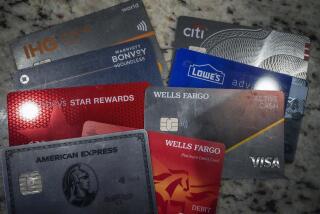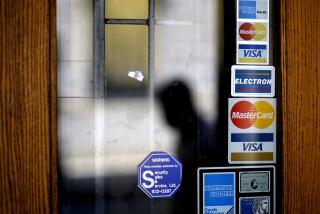Late Payments on Credit Cards Reach Record Level, Trade Group Says
WASHINGTON â The buy-now-pay-later generation is getting deeper into hot water, with late payments on credit cards jumping to a record high in the second quarter.
The American Bankers Assn. said Tuesday that delinquent credit card accounts made up 3.66% of the total number of credit card accounts active between April and June. That figure is up from the 3.53% for the first three months of the year.
The credit-card delinquency ratio is the highest since the ABA began collecting data in 1974, and it represents the seventh straight quarterly increase. The previous peak was for the first quarter of 1991, at 3.34%.
A loan account is considered delinquent when a payment for it is 30 days or more overdue.
Americans owed $454 billion in credit card debt at the end of July, up 18.8% from $382 billion at the same time last year, the trade group said. The July debt figure represents 39% of all consumer lending.
The delinquency trend, for which the association blames looser bank lending standards, is expected to worsen before it improves.
âI would expect that weâll see delinquencies continue to rise somewhat over the next couple of quarters,â said James Chessen, the associationâs chief economist.
âThe good news is that both consumers and lenders have begun to take steps to counter the rise in delinquencies,â he added. Consumers are still taking on more debt, but at a slower pace than in the past, he said.
In other economic news, the government reported that industrial production rose 0.5% in August, a pace that leaves analysts divided about whether the Federal Reserve Board will decide higher interest rates are called for to keep the economy from overheating.
âBy itself, the report points to continued moderate, noninflationary growth,â said economist Mark M. Zandi of Regional Financial Associates in West Chester, Pa. âIt supports a neutral monetary policy with no change.â
Gary Thayer, an economist with A.G. Edwards & Sons, a St. Louis brokerage, disagreed.
âOne of the arguments against raising rates is that the economy would be slowing down,â he contended. âThis report suggests that is not happening yet. To that extent, it suggests the Fed might nudge rates up next week.â
Bond prices were weaker amid a report that a majority of Fed regional bank presidents favor a rate increase. What many investors did not realize, however, is that most of the recommendations to boost the discount rate on loans made to commercial banks by the Fed came at board meetings of regional Fed banks that were held before the government reported last Friday that inflation was lower than anticipated in August and that retail sales for the month fell below expectations.
âI think it would be a hard argument to convince the regional Fed banksâ staffs we should see a hike in the discount rate after Friday,â said David Resler, chief economist at Nomura Securities International Inc. in New York. âFriday was a sea-change event.â
Even so, the decline in Treasuries suggests that many investors took speculation about a discount-rate increase seriously.
Broader market stock indexes were mostly lower on Tuesday, pressured by profit taking after a two-day rally and rising rates in the bond market.
The Fedâs rate committee will meet Tuesday to consider monetary policy. Fed Chairman Alan Greenspan has said the central bank will be forced to tighten credit if the economy does not slow quickly on its own.
Analysts are divided over whether the signs of moderation are such that the Fed will decide to stay on the sidelines. Some describe the evidence as mixed and inconclusive and predict that the Fed will boost short-term rates to 5.5% from 5.25% as insurance. Others contend the lack of any meaningful sign of inflation will permit the Fed to keep rates steady at least until after the November election.
BORROWING TROUBLE
Japan, once known for high savings rate, is now awash in debt. A1
More to Read
Inside the business of entertainment
The Wide Shot brings you news, analysis and insights on everything from streaming wars to production â and what it all means for the future.
You may occasionally receive promotional content from the Los Angeles Times.










